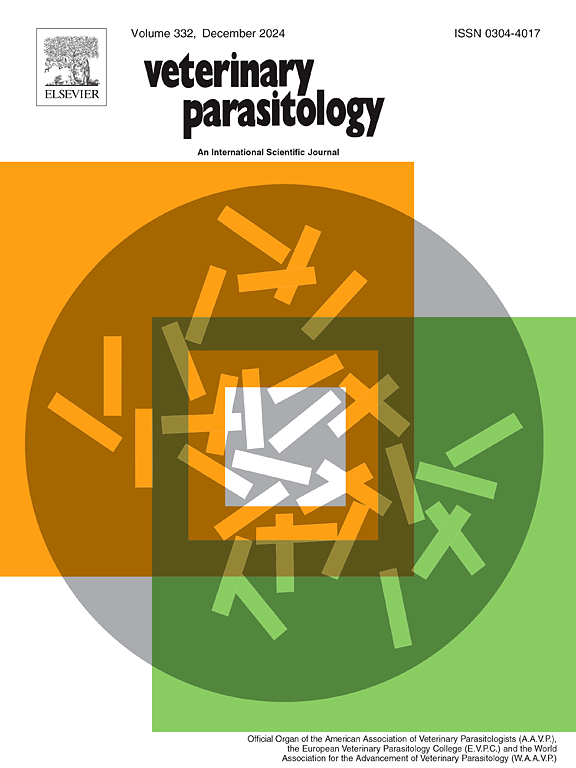一个有着 50 年历史的问题:在野外条件下,亚胺硫磷化学预防能否确保牛的巴贝西亚原虫血清转换?
IF 2
2区 农林科学
Q2 PARASITOLOGY
引用次数: 0
摘要
由牛巴贝斯虫或大牛巴贝斯虫引起的牛巴贝斯虫病是影响牲畜的一种主要蜱媒疾病。在疫苗供应有限的地区,亚胺硫磷被广泛用作化学预防药物。尽管人们认为化学预防可在治疗后短期内产生免疫力,但在咪多卡给药过程中血清转换的程度在很大程度上仍未得到探讨,大多数调查都强调症状预防。本研究试图验证在野外暴露于蜱媒介的情况下接受亚胺硫磷化学预防治疗的牛的血清转换率(体液免疫)。实验使用了 15 头未感染过蜱虫的小母牛,其中 12 头在实验的第 0 天接受了亚胺硫磷(实验组),其余 3 头作为对照组。在研究的第一天,所有动物都被引入蜱虫肆虐的牧场。随后,每隔 28 天(第 28、56、84、112、140 和 168 天),实验组接受一次咪多星处理(1.2 毫克/千克)。使用商业 ELISA 试剂盒检测牛杆菌和大肠杆菌抗体。在整个研究过程中,所有动物都受到 Rhipicephalus microplus 蜱的自然侵扰。在服用两剂咪多卡后的第 56 天,实验组中 25% 的动物已对 B. bovis 发生血清转换,41% 的动物对 B. bigemina 发生血清转换。到第 84 天,66% 的实验组牛杆菌和大肠杆菌血清反应呈阳性。到第 112 天,75% 的牛杆菌血清反应呈阳性。值得注意的是,有一头小母牛(8%)未能对任何一种巴贝西亚原虫进行血清转换,而 41% 的小母牛只对一种巴贝西亚原虫保持血清阳性。这些发现强调了牛巴贝西亚原虫病化学预防方案的某些局限性。虽然大多数接受治疗的牛在连续四次治疗后至少对一种巴贝西亚原虫血清反应呈阳性,但在接受咪多卡化学预防的同时接触寄生虫并不能保证所有接受治疗的动物都能血清转换。本文章由计算机程序翻译,如有差异,请以英文原文为准。
A 50-year-old question: Can imidocarb chemoprophylaxis ensure seroconversion for babesiosis in cattle under field conditions?
Bovine babesiosis, caused by Babesia bovis or Babesia bigemina, is a major tick-borne disease affecting livestock. In regions with limited vaccine availability, imidocarb is widely used as a chemoprophylactic drug. Although it is assumed that chemoprophylaxis allows for the development of immunity shortly after treatment, the extent of seroconversion during the imidocarb administration protocol remains largely unexplored, with most investigations emphasizing symptom prevention. This research endeavors to verify the seroconversion rate (humoral immunity) of cattle undergoing imidocarb chemoprophylaxis while exposed to tick vectors in field conditions. Fifteen tick-naïve heifers were used, with twelve receiving imidocarb (experimental group) on day 0 of the experiment, and the remaining three serving as controls. On day one of the study, all animals were introduced into a tick-infested pasture. Subsequently, at 28-day intervals (days 28, 56, 84, 112, 140, and 168), the experimental group received imidocarb treatments (1.2 mg/Kg). The detection of antibodies against B. bovis and B. bigemina was performed using commercial ELISA kits. Throughout the study, all animals were exposed to natural infestation by Rhipicephalus microplus ticks. By the 56th day, after two imidocarb doses, 25 % of the experimental group had seroconverted for B. bovis, and 41 % for B. bigemina. By the 84th day, 66 % were seropositive for B. bovis and B. bigemina. By the 112th day, 75 % were seropositive for B. bovis. Notably, one heifer (8 %) failed to seroconvert for either species, while 41 % remained seropositive for only one Babesia species. These findings underscore certain limitations of the chemoprophylaxis protocol for bovine babesiosis. While the majority of treated cattle become seropositive for at least one Babesia species after four successive treatments, exposure to the parasite while receiving imidocarb chemoprophylaxis does not guarantee seroconversion for all treated animals.
求助全文
通过发布文献求助,成功后即可免费获取论文全文。
去求助
来源期刊

Veterinary parasitology
农林科学-寄生虫学
CiteScore
5.30
自引率
7.70%
发文量
126
审稿时长
36 days
期刊介绍:
The journal Veterinary Parasitology has an open access mirror journal,Veterinary Parasitology: X, sharing the same aims and scope, editorial team, submission system and rigorous peer review.
This journal is concerned with those aspects of helminthology, protozoology and entomology which are of interest to animal health investigators, veterinary practitioners and others with a special interest in parasitology. Papers of the highest quality dealing with all aspects of disease prevention, pathology, treatment, epidemiology, and control of parasites in all domesticated animals, fall within the scope of the journal. Papers of geographically limited (local) interest which are not of interest to an international audience will not be accepted. Authors who submit papers based on local data will need to indicate why their paper is relevant to a broader readership.
Parasitological studies on laboratory animals fall within the scope of the journal only if they provide a reasonably close model of a disease of domestic animals. Additionally the journal will consider papers relating to wildlife species where they may act as disease reservoirs to domestic animals, or as a zoonotic reservoir. Case studies considered to be unique or of specific interest to the journal, will also be considered on occasions at the Editors'' discretion. Papers dealing exclusively with the taxonomy of parasites do not fall within the scope of the journal.
 求助内容:
求助内容: 应助结果提醒方式:
应助结果提醒方式:


